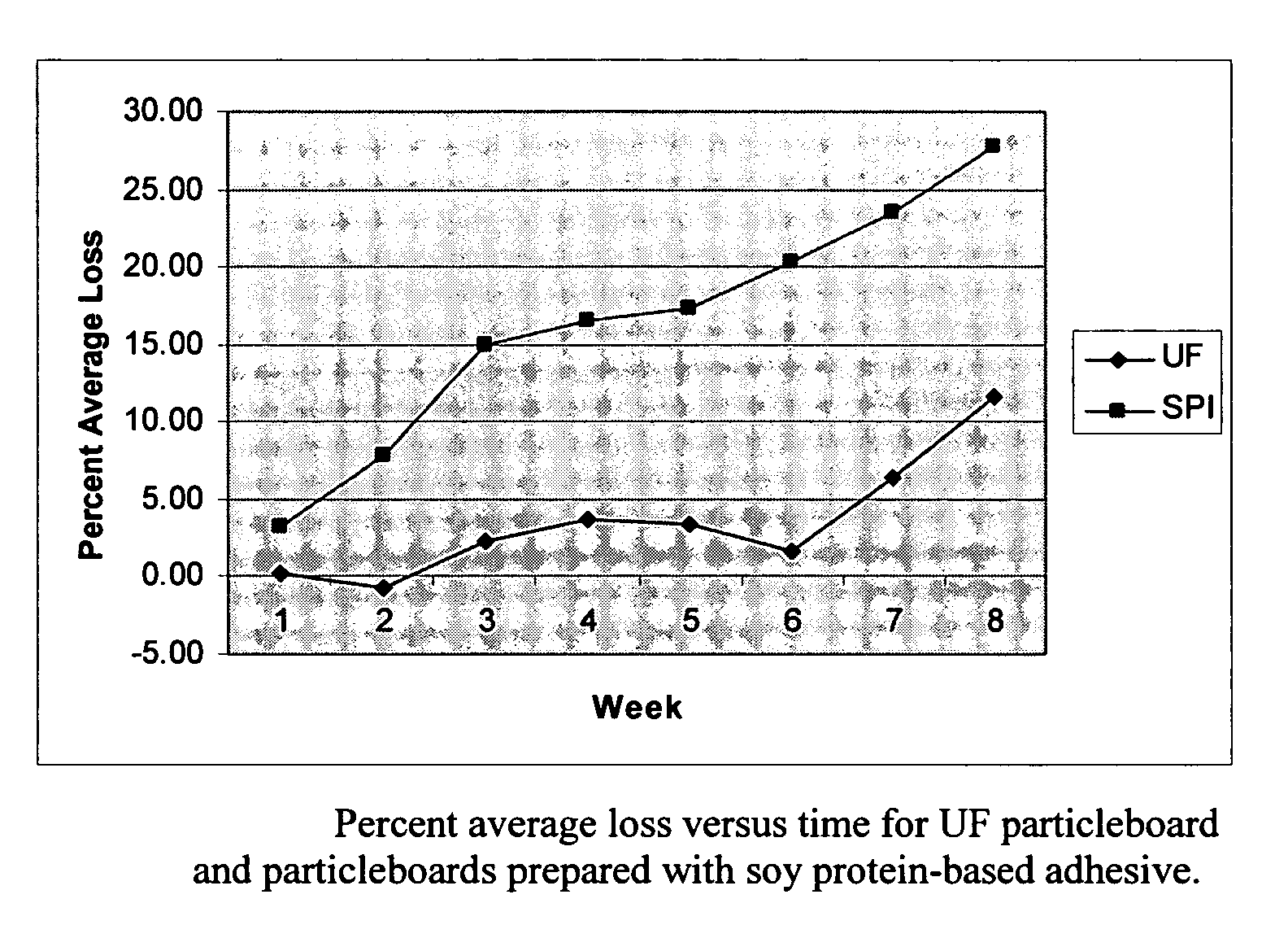Soy protein based adhesive and particleboard
a technology of soy protein and adhesive, applied in the field of soy protein based adhesive and particleboard, can solve the problem of low moisture resistan
- Summary
- Abstract
- Description
- Claims
- Application Information
AI Technical Summary
Benefits of technology
Problems solved by technology
Method used
Image
Examples
examples 1 – 3
EXAMPLES 1–3
[0015]For the adhesive shown in Example 1, a water bath is heated to 40° C. and a 4 L reaction kettle is charged with 2571.0 grams of water. 4.90 grams of zinc sulfate heptahydrate, 33.1 grams of calcium oxide, 33.1 grams of sodium benzoate, and 17.8 grams of pine oil are then added to the reaction kettle. The reaction kettle lid is fitted with a four-propeller stirrer, a thermometer, rubber septum, and clamp. The lid is then securely attached to the kettle and the kettle is submerged in the 40° C. bath. The stirrer is attached to a mechanical stirring motor and the contents of the kettle are stirred for five minutes at 600 rpm. Approximately 400 grams of SPI are added over the course of 20 minutes. The mixture is allowed to homogenize for approximately 30 minutes and 92.7 additional grams of SPI are added. The mixture is allowed to react for an additional 60 minutes. Next, 101.7 grams of wax emulsion are added and allowed to homogenize with the reaction mixture for five...
examples 4 – 6
EXAMPLES 4–6
[0023]For the adhesive shown in Example 4, a water bath is heated to 40° C. and a 4 L reaction kettle equipped with a stirrer and a thermometer is immersed in it. The kettle is charged with 2780.6 grams of water and stirred slowly for 15 minutes. The agitation is increased to 600 rpm and 35.7 grams of calcium oxide is added slowly. The kettle is then serially charged with 5.4 grams of zinc sulfate heptahydrate, 35.7 grams of sodium benzoate, and 19.3 grams of pine oil. The contents are stirred for five minutes before slowly adding 532.8 grams of SPI over 50 minutes. The mixture is stirred for an hour and 110.0 grams of wax emulsion is added slowly followed by 37.5 grams of non-sulfonated kraft lignin. The mixture is homogenized for 15 minutes, and the kettle is transferred to another water bath at ambient conditions for cooling. The agitation is increased to 1800 rpm and 80.0 grams of concentrated nitric acid is added over the next 30 minutes. The adhesive is now ready t...
example 7
[0032]An adhesive composition was prepared in the same manner as Example 5 except that defatted soy flour was used in place of the soy protein isolate. The final composition of the adhesive is set forth in Table 3a.
[0033]
TABLE 3aNeutralized Adhesive Made with Defatted Soy FlourExample 7ComponentWeight %Water70.36Zinc sulfate heptahydrate0.19Calcium oxide1.24Sodium benzoate1.24Pine oil0.67Defatted soybean flour18.44Wax emulsion3.81Non-sulfonated kraft lignin1.30Nitric acid2.77
[0034]Two three-layer particleboards were prepared in the same manner as Example 5 but using the adhesive of Example 7. The mechanical and physical properties of particleboards 7a and 7b are shown in Table 4a.
[0035]
TABLE 4aMechanical and Physical Properties SummaryDensityMCMORMOETSWAParticleboardlb / ft3%psipsi%%7a49.76.018734095605.512.37b49.65.418484122335.612.7
PUM
| Property | Measurement | Unit |
|---|---|---|
| temperature | aaaaa | aaaaa |
| temperature | aaaaa | aaaaa |
| temperature | aaaaa | aaaaa |
Abstract
Description
Claims
Application Information
 Login to View More
Login to View More - R&D
- Intellectual Property
- Life Sciences
- Materials
- Tech Scout
- Unparalleled Data Quality
- Higher Quality Content
- 60% Fewer Hallucinations
Browse by: Latest US Patents, China's latest patents, Technical Efficacy Thesaurus, Application Domain, Technology Topic, Popular Technical Reports.
© 2025 PatSnap. All rights reserved.Legal|Privacy policy|Modern Slavery Act Transparency Statement|Sitemap|About US| Contact US: help@patsnap.com


